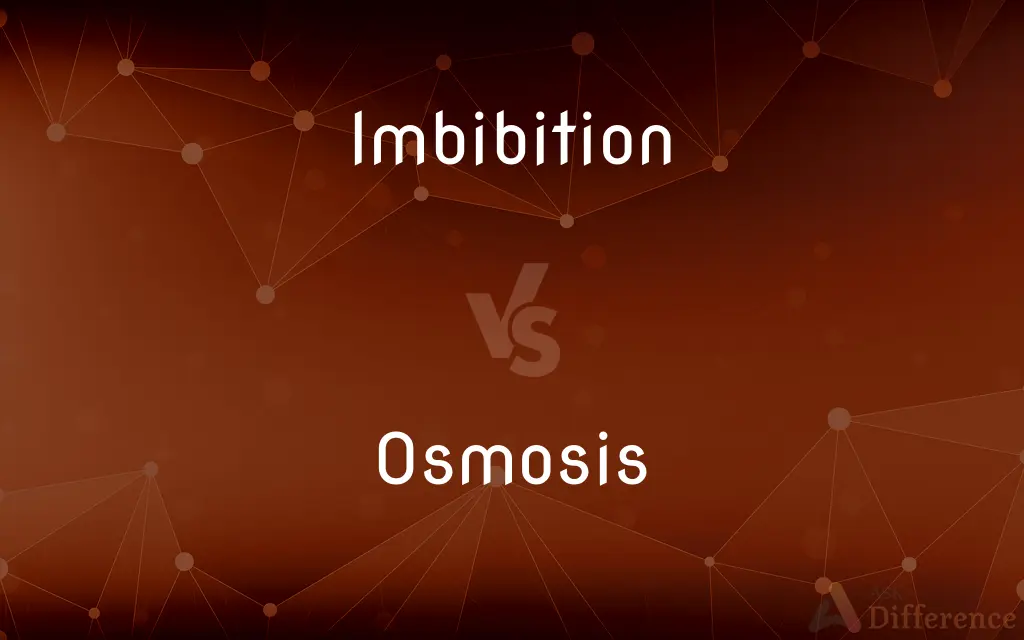Imbibition vs. Osmosis — What's the Difference?
Edited by Tayyaba Rehman — By Fiza Rafique — Updated on March 8, 2024
Imbibition involves the absorption of water by solids, leading to swelling, while osmosis is the movement of water through a semipermeable membrane from low to high solute concentration.

Difference Between Imbibition and Osmosis
Table of Contents
ADVERTISEMENT
Key Differences
Imbibition is a process where water is absorbed by solids, causing them to swell without forming a solution. It's crucial in biological contexts, like seeds absorbing water for germination. Osmosis, on the other hand, is a fundamental biological process where water molecules move through a semipermeable membrane from an area of low solute concentration to one of high solute concentration, crucial for maintaining cellular environments.
While imbibition is not selective and does not require a membrane, osmosis specifically involves the movement of water across a semipermeable membrane. This difference highlights the selective nature of osmosis in biological systems, as opposed to the non-selective absorption in imbibition.
Imbibition's effectiveness is influenced by the affinity between the absorbent material and water, whereas osmosis is driven by the concentration gradient of solutes on either side of the membrane. This contrast underlines the role of solute concentration in osmosis, unlike in imbibition where affinity plays a more significant role.
In imbibition, the pressure developed due to swelling can be substantial, used in practical applications like swelling of wooden furniture joints. In contrast, osmotic pressure in osmosis can cause cells to swell or shrink, crucial for cell stability and function.
Imbibition does not require energy, as it is driven by the capillary forces within the porous material, while osmosis can involve active or passive transport, with the latter not requiring energy but the former needing cellular energy in the form of ATP for movement against the concentration gradient.
ADVERTISEMENT
Comparison Chart
Definition
Absorption of water by solids, causing them to swell.
Movement of water across a semipermeable membrane from low to high solute concentration.
Selectivity
Non-selective, does not require a membrane.
Selective, requires a semipermeable membrane.
Driving Force
Affinity between material and water, capillary action.
Concentration gradient of solute across the membrane.
Energy Requirement
Typically does not require energy.
Can be passive (no energy) or active (requires energy).
Practical Example
Swelling of seeds for germination, wooden furniture joints.
Regulation of cell volume and internal environment.
Compare with Definitions
Imbibition
Non-selective process.
Imbibition can occur with various liquids and solids.
Osmosis
Movement of water through a semipermeable membrane.
Water entering a plant cell.
Imbibition
Absorption of water causing swelling.
Seeds swell during germination.
Osmosis
Essential for life processes.
Key in kidney function and plant nutrient uptake.
Imbibition
No membrane required.
Water is absorbed directly by the solid material.
Osmosis
Can involve passive or active transport.
Osmosis usually does not require energy but can in certain cells.
Imbibition
Driven by capillary forces.
Water rises in narrow spaces due to capillary action.
Osmosis
Maintains cell volume and internal environment.
Prevents cells from swelling or shrinking excessively.
Imbibition
Common in nature and industry.
Used in agriculture and woodworking.
Osmosis
Selective process based on solute concentration.
Osmosis occurs towards higher solute concentration.
Imbibition
Imbibition is a special type of diffusion that takes place when water is absorbed by solids-colloids causing an increase in volume. Examples include the absorption of water by seeds and dry wood.
Osmosis
Osmosis (, US also ) is the spontaneous net movement or diffusion of solvent molecules through a selectively permeable membrane from a region of high water potential (region of lower solute concentration) to a region of low water potential (region of higher solute concentration), in the direction that tends to equalize the solute concentrations on the two sides. It may also be used to describe a physical process in which any solvent moves across a selectively permeable membrane (permeable to the solvent, but not the solute) separating two solutions of different concentrations.
Imbibition
The act of imbibing.
Osmosis
Diffusion of fluid through a semipermeable membrane from a solution with a low solute concentration to a solution with a higher solute concentration. Osmosis ceases when there is an equal solute concentration on both sides of the membrane.
Imbibition
(Chemistry) Absorption of fluid by a colloid or porous solid that often results in swelling.
Osmosis
The tendency of fluids to diffuse in such a manner.
Imbibition
The act of imbibing.
Osmosis
A gradual, often unconscious process of assimilation or absorption
Learned French by osmosis while residing in Paris for 15 years.
Imbibition
The act or process of imbibing, or absorbing; as, the post-mortem imbibition of poisons.
Osmosis
(chemistry) The net movement of solvent molecules, usually water, from a region of lower solute concentration to a region of higher solute concentration through a partially permeable membrane.
Imbibition
(chemistry) the absorption of a liquid by a solid or gel
Osmosis
(figurative) Passive absorption or impartation of information, habits, etc.; the act of teaching or picking up knowledge incidentally, without actually seeking that particular knowledge.
I was reading about chickens, and I guess I learned about hawks through osmosis.
Imbibition
The act of consuming liquids
Osmosis
The tendency in fluids to mix, or become equably diffused, when in contact. It was first observed between fluids of differing densities, and as taking place through a membrane or an intervening porous structure. An older term for the phenomenon was Osmose.
Osmosis
Diffusion of molecules through a semipermeable membrane from a place of higher concentration to a place of lower concentration until the concentration on both sides is equal
Common Curiosities
Is energy required for imbibition?
No, imbibition generally does not require energy as it is driven by capillary forces.
What is osmosis?
Osmosis is the movement of water through a semipermeable membrane from an area of low to high solute concentration.
What is imbibition?
Imbibition is the absorption of water by solids, causing them to swell.
How does imbibition differ from osmosis?
Imbibition involves water absorption by solids leading to swelling, without a membrane, while osmosis requires a semipermeable membrane and involves water movement based on solute concentration.
Is energy required for osmosis?
Osmosis can be passive, requiring no energy, or active, requiring energy in certain cases.
Can imbibition occur with any liquid?
While typically associated with water, imbibition can occur with any liquid that has an affinity for the solid material.
What is a semipermeable membrane?
A semipermeable membrane is a barrier that allows certain molecules or ions to pass through it by diffusion and occasionally specialized "facilitated diffusion."
What is osmotic pressure?
Osmotic pressure is the pressure required to prevent the inward flow of water across a semipermeable membrane.
What roles do affinity and concentration gradients play in imbibition and osmosis, respectively?
In imbibition, the affinity between the absorbent material and water is key, while in osmosis, the solute concentration gradient across the membrane drives the process.
Can osmosis occur in artificial systems?
Yes, osmosis can be observed in artificial systems using membranes that mimic biological semipermeable membranes.
What is an example of a practical application of imbibition?
Swelling of wooden furniture joints for a tight fit is a practical application of imbibition.
How does osmosis affect plant health?
Osmosis is crucial for nutrient uptake and maintaining turgor pressure in plants, affecting their health and growth.
How does osmosis regulate cell volume?
Osmosis balances the inflow and outflow of water, maintaining stable cell volume and internal conditions.
How does imbibition contribute to seed germination?
Imbibition causes seeds to swell, breaking the seed coat and initiating germination.
What is the difference between active and passive osmosis?
Active osmosis requires energy for water to move against the concentration gradient, whereas passive osmosis does not require energy, following the concentration gradient.
Share Your Discovery

Previous Comparison
Piano vs. Plink
Next Comparison
Nonrigorous vs. RigorousAuthor Spotlight
Written by
Fiza RafiqueFiza Rafique is a skilled content writer at AskDifference.com, where she meticulously refines and enhances written pieces. Drawing from her vast editorial expertise, Fiza ensures clarity, accuracy, and precision in every article. Passionate about language, she continually seeks to elevate the quality of content for readers worldwide.
Edited by
Tayyaba RehmanTayyaba Rehman is a distinguished writer, currently serving as a primary contributor to askdifference.com. As a researcher in semantics and etymology, Tayyaba's passion for the complexity of languages and their distinctions has found a perfect home on the platform. Tayyaba delves into the intricacies of language, distinguishing between commonly confused words and phrases, thereby providing clarity for readers worldwide.














































